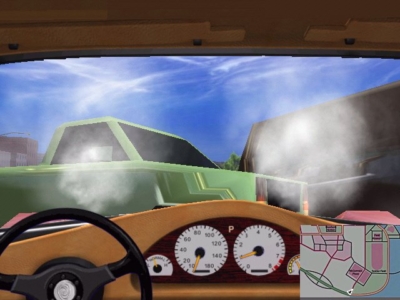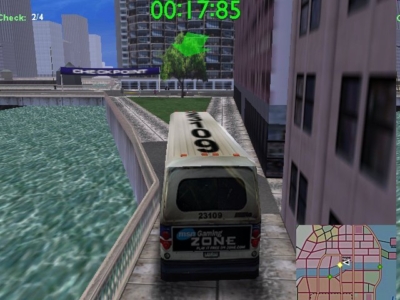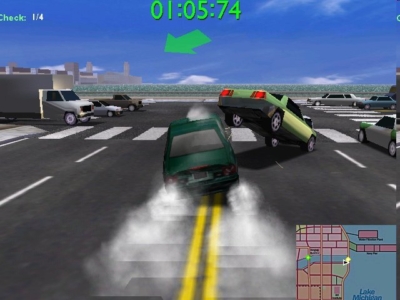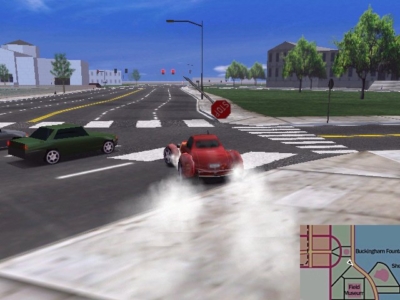
Midtown Madness
Written by: Rik
Date posted: September 2, 2004
- Genre: Racing
- Developed by: Angel Studios
- Published by: Microsoft
- Year released: 1999
- Our score: 7
Midtown Madness is a hard game to like. For a start, it’s published by Microsoft, the company that enforces the worldwide use of its terrible operating systems by virtue of sheer economic muscle. Before 1999 they weren’t too hot at producing games, either; previous forays included the unremarkable Al Unser Jr’s Arcade Racing and the derisory Microsoft Soccer, a game so bad it received single-figure percentage scores across the board.
A glance at the Midtown Madness packaging doesn’t indicate significant progress. The screenshots are less than flattering, while the advertising blurb is the worst imaginable kind of excitable hyperbole (“Rules and stoplights are for wimps! Smash through a shopping mall, outrun the cops, or play chicken with the planes at the airfield!”). The overall impression is of a low budget piece of trash, hastily cobbled together in order to cash in on a forthcoming blockbuster, in this case PSX conversion, Driver. These fears proved to be unfounded, however, and on release Midtown Madness received plenty of favourable reviews. Murmurs of “worthy stopgap” persisted, though, and it was only after the hollow disappointment of Driver on PC that people truly appreciated Midtown’s quality.
Anyway, the game’s title pretty much gives away what it’s all about. The town in question is Chicago, Illinois and the madness refers to the fact that you can drive all around it with gay abandon. You can, as the box suggests, ignore traffic lights, smash through a shopping centre or outrun the police, although playing chicken with an aeroplane isn’t strictly possible (the one that appears in the game never actually lands or takes off).
In fact, select Midtown’s cruise mode, and you?ll be able to do entirely as you please, exploring the pleasingly-recreated Chicago centre at your leisure. The city isn’t mapped completely accurately, but (so I’m told), it’s a close approximation of the real thing, with all of the major landmarks in their correct locations, and the playing area is large enough for it to take some time before you really know your way around. Like Grand Theft Auto, you can easily waste a good few hours buggering about with absolutely no purpose whatsoever. You can even do so to your own soundtrack, although this is pre-MP3 – you’ll have to dig out some CDs to avoid listening to the generic toss on the game disc.
While this is quite good fun for a while, some much-needed focus is provided by the game’s various race modes. Checkpoint mode sees you racing against AI competitors, trying to find the fastest route through the designated checkpoints spread across the city. Blitz mode is a race against the clock, with the location of the next checkpoint only revealed once you have made it through the last. Circuit mode, meanwhile, does what is says on the tin, excluding the “living city” element of the game in favour of a simple race around a cordoned-off section of Chicago. Of these, the first two are the most fun, mainly because they play to Midtown’s strengths – utilising the city elements of the game, placing emphasis on knowledge of the roads and finding short cuts. In circuit mode, however, the limitations of the opponents’ AI and the handling of the vehicles are exposed; virtually any “serious” racing game does this sort of thing a whole lot better.
Still, once you learn to ignore this mode altogether, many a happy hour can be spent trying to complete the Blitz and Checkpoint challenges. Blitz provides an immediate, arcade excitement; despite the huge playing area, your focus is generally on quite a small section of the city, and even the smallest adjustment in route can mean valuable extra seconds on the way to the next checkpoint. Checkpoint mode, meanwhile, often requires a little forward planning, and the races tend to be longer and a little more challenging to complete successfully. it’s good, addictive fun, with the well-judged learning curve allowing for some long playing sessions, and the unlocking system (new cars as well as challenges) serving as an added incentive to have another go.
The selection of vehicles is a little bizarre; perhaps to fit in with the “go mad in the city” theme of the game, most of the cars are mundane, affordable motors. There is a mildly exciting-looking sportster on offer, although its twitchy handling and low capacity for damage mean you’ll often opt for one of the deeply uninteresting saloon cars instead. Do well and you’ll be able to unlock some extra vehicles, including a city bus, which is of little use except for twatting around in cruise mode, and a 1970s Ford Mustang, which looks very cool but is essentially the same in performance as the cars you already have at your disposal.
All of the vehicles handle fairly realistically; Midtown may essentially be an arcade racer, but there are no powerslides here. Take a corner too quickly and you’ll spin out of control – and yes, you do have to use the brakes on occasion. While there’s certainly no place for tinkering with gear ratios in a game such as this, it’s still nice to see cars that behave something like the real thing. It adds to the sense of realism in the city, too; switch to manual gears and turn on the dashboard view, and you’ll find it’s surprisingly easy to drive “normally” without too many mishaps. By and large, the traffic behaves itself too, although occasionally a van will slam into you while you’re waiting at some lights.
Other notable features include adjustable weather, pedestrians (no, you can’t run them over) and the police, who turn up at regular intervals throughout. They’re not the most sophisticated of souls, though, and serve mainly as an irritant, weaving all over the road and smashing into various obstacles (sometimes including your car). More often than not they’ll stick on your tail for a couple of minutes, picking up damage before inexplicably ploughing into a nearby wall. This is a little disappointing, although given the scope of Midtown’s city, more sophisticated police AI may have been difficult to implement.
Graphically stunning in 1999, Midtown’s visuals now look a little dated, but if you crank the detail up there’s very little to complain about. The vehicles still look good (although the generic traffic looks very boxy and samey) and the scale of the city is impressive. Sound-wise, the music will have you reaching for the volume controls (note: not to turn it up), but it can easily been replaced with your own tunes, but the engine and collision sounds do their job, and are supplemented by some excellent angry-driver-shouting effects which raise the odd smirk. For some reason some irritating US radio DJ also features, spouting inanities at various points, but fortunately you can turn him off as well.

Stick the dashboard view on, gears to manual, and try and drive normally. You’ll have ever so much fun.
In recent years unfavourable comparisons with Grand Theft Auto III have been made, and in truth GTA’s mammoth playing area and attention to detail certainly make the Chicago of Midtown look rather bland and basic. However, GTA III is a crime sim, not a racer, and while it does feature the occasional checkpoint race, the basic, gearless approach to driving lends itself more to exploration than anything else. While Midtown’s box may boast about zany antics in the city, this basically amount to driving on the grass and knocking over litter bins; in truth, it’s the racing that satisfies. If you want to be able to drive about in a huge city where there’s violence around every corner and you can run over pedestrians, then GTA has it by a country mile. If you want a more straightforward racer in a city boasting a sunny, Microsoft sheen where the pedestrians always jump out of the way of your car, then Midtown is probably more your cup of tea.
Midtown Madness is a simple, fun racing game with a relatively short life span. For the first few weeks it’ll more than hold your attention as your work your way through the races. Once you complete them all, or get horribly stuck, there’s not an awful lot to keep you coming back, although the occasional half-hour in cruise mode may still satisfy. Despite this, it’s well worth a look if you crave fun, real world driving that isn’t Need for Speed and which doesn’t involve getting involved in the criminal underworld.





 Posts
Posts